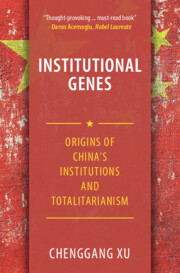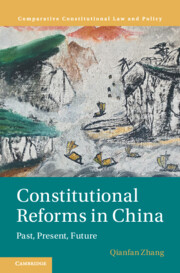Refine search
Actions for selected content:
78 results
Chapter 11 - Conclusion
-
-
- Book:
- Questioning Conventional Assumptions of Competition Dynamics
- Published online:
- 07 May 2025
- Print publication:
- 21 August 2025, pp 264-300
-
- Chapter
- Export citation
Chapter 6 - Competition in the (Former) Totalitarian Countries’ Political Arenas
-
-
- Book:
- Questioning Conventional Assumptions of Competition Dynamics
- Published online:
- 07 May 2025
- Print publication:
- 21 August 2025, pp 141-182
-
- Chapter
- Export citation
7 - Institutional Genes of Totalitarianism
-
- Book:
- Institutional Genes
- Published online:
- 03 June 2025
- Print publication:
- 26 June 2025, pp 261-314
-
- Chapter
- Export citation
9 - The Failure of Constitutional Reforms and Republican Revolution
-
- Book:
- Institutional Genes
- Published online:
- 03 June 2025
- Print publication:
- 26 June 2025, pp 392-448
-
- Chapter
- Export citation
10 - Building China’s Bolshevik Party
-
- Book:
- Institutional Genes
- Published online:
- 03 June 2025
- Print publication:
- 26 June 2025, pp 449-498
-
- Chapter
- Export citation
6 - The Institutional Genes of Totalitarian Ideology
-
- Book:
- Institutional Genes
- Published online:
- 03 June 2025
- Print publication:
- 26 June 2025, pp 202-260
-
- Chapter
- Export citation
14 - Conclusion
-
- Book:
- Institutional Genes
- Published online:
- 03 June 2025
- Print publication:
- 26 June 2025, pp 658-724
-
- Chapter
- Export citation
8 - The Birth of Bolshevik Totalitarianism
-
- Book:
- Institutional Genes
- Published online:
- 03 June 2025
- Print publication:
- 26 June 2025, pp 315-391
-
- Chapter
- Export citation
6 - The Holocaust and Modernity
-
-
- Book:
- The Cambridge History of the Holocaust
- Published online:
- 16 May 2025
- Print publication:
- 12 June 2025, pp 113-133
-
- Chapter
- Export citation
13 - Communism and Anticommunism
-
-
- Book:
- The Cambridge History of the Holocaust
- Published online:
- 16 May 2025
- Print publication:
- 12 June 2025, pp 268-287
-
- Chapter
- Export citation

Institutional Genes
- Origins of China's Institutions and Totalitarianism
-
- Published online:
- 03 June 2025
- Print publication:
- 26 June 2025
Debating Maoism in Contemporary China: Reflections on Benjamin I. Schwartz, Chinese Communism and the Rise of Mao
-
- Journal:
- Asia-Pacific Journal / Volume 19 / Issue 1 / January 2021
- Published online by Cambridge University Press:
- 14 March 2025, e1
-
- Article
-
- You have access
- Open access
- Export citation
Claude Lefort in the age of the total constitution
-
- Journal:
- Global Constitutionalism , First View
- Published online by Cambridge University Press:
- 11 March 2025, pp. 1-27
-
- Article
-
- You have access
- Open access
- HTML
- Export citation
3 - The Rise and Fall of Totalitarianism
-
- Book:
- Constitutional Reforms in China
- Published online:
- 19 December 2024
- Print publication:
- 02 January 2025, pp 83-129
-
- Chapter
- Export citation

Constitutional Reforms in China
- Past, Present, Future
-
- Published online:
- 19 December 2024
- Print publication:
- 02 January 2025
10 - Democracy versus Autocracy
- from Part III - East Asia since 1945
-
- Book:
- East Asian International Relations
- Published online:
- 28 November 2024
- Print publication:
- 19 December 2024, pp 280-309
-
- Chapter
- Export citation
Smells and politics of Utopia – Corrigendum
-
- Article
-
- You have access
- Open access
- HTML
- Export citation
The Insidious Ambiguity of “Ideology”
-
- Journal:
- Social Philosophy and Policy / Volume 41 / Issue 1 / Summer 2024
- Published online by Cambridge University Press:
- 13 January 2025, pp. 62-83
- Print publication:
- Summer 2024
-
- Article
- Export citation
Smells and politics of Utopia
-
- Article
-
- You have access
- Open access
- HTML
- Export citation
Chapter 8 - The Socratic Gadfly (Haematopota oxyglotta socratis)
-
- Book:
- The Trojan Horse and Other Stories
- Published online:
- 09 November 2023
- Print publication:
- 11 January 2024, pp 187-208
-
- Chapter
- Export citation
